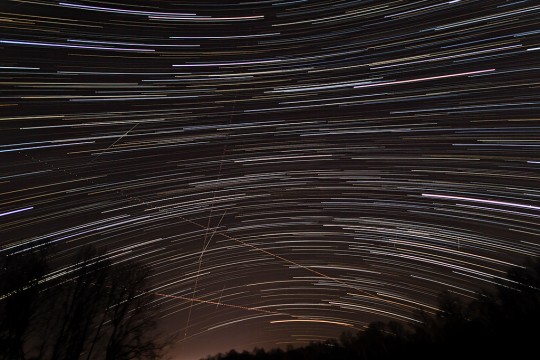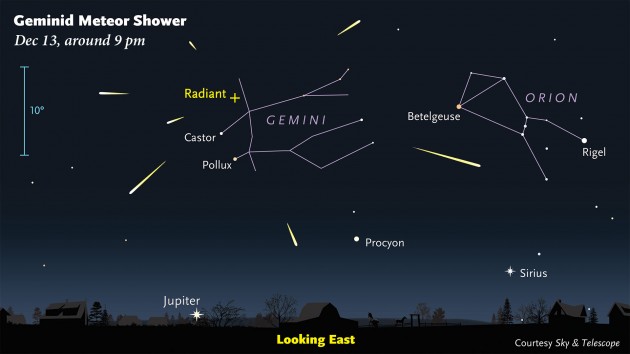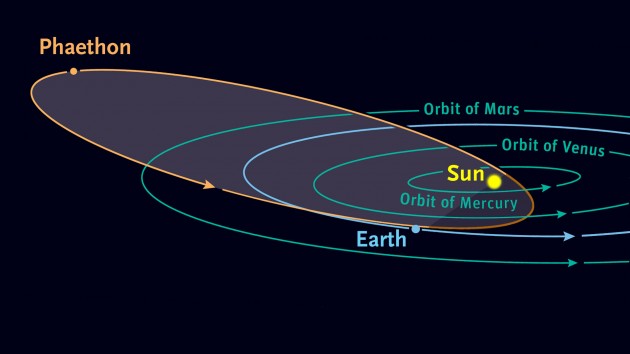The Geminids, an impressive annual meteor shower sparked by dust and debris shed from a small asteroid, peaks this weekend.

Jeff Smallwood
If the skies are clear this weekend, head outside on Saturday and Sunday nights (December 13th and 14th) for the annual show put on by the Geminid meteor shower. Although some people prefer the summer Perseids – warm weather skywatching! – the December Geminids sometimes out-perform the summer shower in terms of visibility and frequency.
Under a clear, dark sky, you might see a shooting star every minute from 10 p.m. local time until dawn on the peak nights. If you live under the artificial skyglow of light pollution the numbers will be reduced, but the brightest meteors will still shine through. There will be some interference as well from a last-quarter Moon, which rises close to midnight.
Not a night owl? Give the evening sky a chance. Lower counts of Geminid meteors should be visible earlier on Saturday and Sunday evenings (and possibly even Friday and Monday evenings).
Where to Look
To watch for meteors, you need no equipment other than your eyes. Find a dark spot with an open view of the sky and no glaring lights nearby. Bundle up as warmly as you can in many layers. “Go out late in the evening, lie back in a reclining lawn chair, and gaze up into the stars,” says our senior editor, Alan MacRobert. “Relax, be patient, and let your eyes adapt to the darkness."

Sky & Telescope / Gregg Dinderman
Geminids can appear anywhere in the sky, so the best direction to watch is wherever your sky is darkest, probably straight up. Small particles create tiny, quick streaks. Occasional brighter ones might sail across the heavens for several seconds and may leave a brief train of glowing smoke.
If you trace each meteor’s direction of flight backward far enough across the sky, you’ll find that this imaginary line crosses a spot in the constellation Gemini near the stars Castor and Pollux. Gemini is low in the eastern sky during late evening and climbs to high overhead in the hours after midnight (for skywatchers at north-temperate latitudes). The special spot is called the shower’s radiant. It’s the perspective point from which all the Geminids would appear to come if you could see them approaching from far away, rather than just in the last second or so of their lives as they dive into Earth’s upper atmosphere.
Origins
Where do the Geminid meteors originate, and why do we see them in December? Meteor showers happen when our planet plows through a stream of fine particles that have been shed by a comet and spread out along its orbit.

Sky & Telescope diagram
But the Geminid meteors are different: they're created by tiny bits of rocky debris (the size of sand grains to peas) shed from a small asteroid named 3200 Phaethon, which was discovered in 1983. Before then no one knew the source of the Geminid shower. Phaethon is small, only about 3 miles across. It loops around the Sun every 1.4 years in an orbit that approaches the Sun closer than any other named asteroid (though several others with temporary designations have smaller perihelia).
Over the centuries bits of Phaethon have spread all along the asteroid’s orbit to form a sparse, moving “river of rubble” that Earth passes through in mid-December each year. The particles are traveling 22 miles per second (79,000 mph) with respect to Earth at the place in space where we encounter them. So when one of them dives into Earth’s upper atmosphere, about 50 to 80 miles up, air friction vaporizes it in a quick, white-hot streak.
But It's Raining!
Weather not cooperating? Too cold for your toes? The internet has you covered. Gianluca Masi will be hosting online coverage of the shower via the Virtual Telescope Project 2.0. Coverage begins at 9:00 p.m. EST on Saturday, December 13, 2014. Coverage by the Slooh robotic observatory begins later that night, at 11:00 p.m. EST. A team of astronomers from NASA will also be hosting a web chat from 11 p.m. to 1:00 EST, answering questions about the meteor shower.
You'll never miss an event in 2015 if you keep the Sky & Telescope Stargazer's Almanac handy! Available for latitudes 40° north, 50° north, and 30° south.
 0
0
Comments
You must be logged in to post a comment.